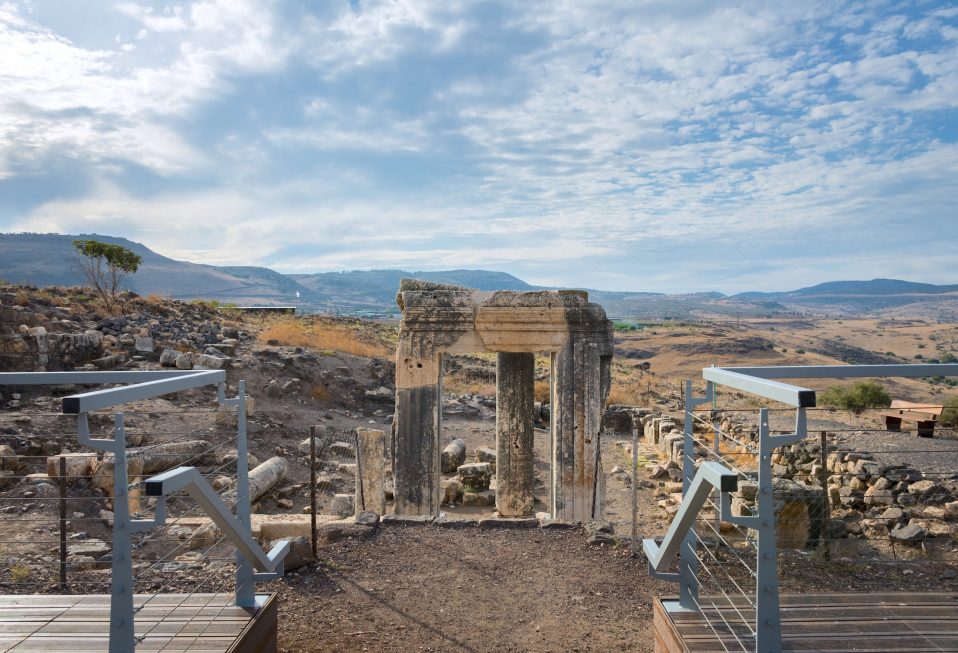By Marc Turnage
Arbel sits high upon the sheer limestone cliffs along the northwest corner of the lake of Galilee, northwest of Tiberias, overlooking the fertile plain of Gennesar. The Arbel Cliffs form the southern boundary of the plain of Gennesar and provide a striking visual landmark along the northwest shores of the lake. From here, visitors can see the geography on the northern shores of the lake of Galilee where 95% of Jesus’ ministry recorded in the Gospels took place.
Arbel could be identified with Beth-Arbel mentioned in the prophecy of Hosea (10:14). The current site of Arbel, however, began at the end of the second century B.C. The settlement most likely started as part of Hasmonean settlement of the Galilee when Jewish immigrants from Judea moved into the region. Rabbinic tradition identifies a Sage, Nittai, who lived in the second half of the second century B.C., as from Arbel (m. Avot 1:6-7). He served as the head of the Sanhedrin (m. Hagigah 2:2). His prominent position within Jewish society indicates a significant Jewish religious presence in Galilee at the end of the second century B.C.
After the destruction of the Jerusalem Temple in A.D. 70, the priestly division of Yeshua, the ninth priestly division, settled at Arbel. Arbel was principally known for the growing of flax from which the inhabitants produced linen (Genesis Rabbah 19:1). The Arbel Valley was also known for its agricultural fertility, especially the production of grain (y. Peah 7, 4, 20a). Excavations uncovered wine and olive presses, as well as large pools, probably used for the processing of flax.
Arbel was the location of a clash between the Hasmonean forces of Antigonus and Herod (c. 39-38 B.C.). After Herod gained control of Sepphoris, he sent his force “to the village of Arbela,” and after 40 days, Herod’s forces fought the supporters of Antigonus (Josephus, War 1:305-313). Herod’s forces won the battle, and Antigonus’ supporters fled some taking refuge in caves “very near the village” of Arbel (Antiquities 14:415). There are three groups of caves in the cliffs of Mount Arbel, and most likely the rebels sought refuge in the western group of caves, which are the closest to the village of Arbel (approximately 400 meters).
Herod eventually dealt with the rebels held-up in the caves. His forces could not make a direct assault on the caves due to the sheerness of the cliffs. His engineers constructed baskets to lower soldiers down the cliff face by machines anchored to the summit of the hill. The soldiers, armed with grappling hooks, fished the brigands out of the caves hurling them to the rocks below. Soldiers hurled fire into the caves to force the rebels out of them. Some of the rebels threw themselves along with their families down the cliffs while Herod watched from a fortified position on an opposite hill.
During the First Jewish revolt against Rome, Josephus fortified the “cave of Arbel” (Life 188; see Life 311; and War 2:573). Josephus likely fortified the eastern group of caves on the Arbel Cliffs where there are remains of actual fortifications. He also quite possibly utilized the western group of caves previously used by the supporters of Antigonus against Herod.
Today visitors can hike to the overlook from the cliffs of the Gennesar Valley and the northern shore of the Sea of Galilee. They can also see the remains of a limestone synagogue built in the fourth century A.D., which continued in use until the eighth century A.D. Renovations were made in the late sixth or early seventh century A.D.
Marc Turnage is President/CEO of Biblical Expeditions. He is an authority on ancient Judaism and Christian origins. He has published widely for both academic and popular audiences. His most recent book, Windows into the Bible, was named by Outreach Magazine as one of its top 100 Christian living resources. Marc is a widely sought-after speaker and a gifted teacher. He has been guiding groups to the lands of the Bible—Israel, Jordan, Egypt, Turkey, Greece, and Italy—for over twenty years.
Website: WITBUniversity.com
Facebook: @witbuniversity
Podcast: Windows into the Bible Podcast




Post a comment